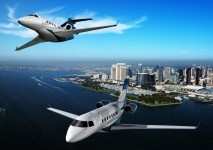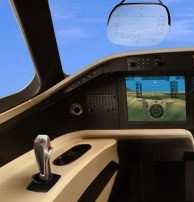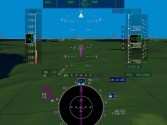Man-Machine Interface (MMI) Advisory Board Weighs In On
Development Program
 Embraer says its midlight
Legacy 450 (right above) and midsize Legacy 500 (right
below) executive jet development programs are continuing
pretty much as planned. The concepts were presented at the 2007
NBAA Annual Meeting and Convention, in Atlanta, Georgia, and the
company says it is still committed to developing these
aircraft.
Embraer says its midlight
Legacy 450 (right above) and midsize Legacy 500 (right
below) executive jet development programs are continuing
pretty much as planned. The concepts were presented at the 2007
NBAA Annual Meeting and Convention, in Atlanta, Georgia, and the
company says it is still committed to developing these
aircraft.
The second Man-Machine Interface (MMI) Advisory Board, formed by
seasoned pilots and aircraft owners from around the world, was held
at Embraer’s headquarters in São José dos
Campos, Brazil, in the second half of 2009. The majority of the
Board’s previous suggestions were implemented in the final
projects of the jets, confirming Embraer’s commitment to
design aircraft that meet market demands. As a result of one of the
suggestions, the Company now offers a broader range of finishing
materials. Guided by six different thematic panels, customers can
select the interior configuration that best matches their
interests, from among millions of possible combinations.
“As we begin producing the first parts for the Legacy 450
and Legacy 500 jets, we are always open to learning from our
customers,” said Luís Carlos Affonso, Embraer
Executive Vice President, Executive Jets. “Listening to our
customers has been an Embraer trade mark. I believe this is the
right attitude to have when designing products that respond to
market needs, and are intended to always provide customers with a
remarkable ownership experience.”

Pilot's View Artist's
Concept
Various manufacturing processes are in the testing phase.
Quality and maturity tests are also being conducted to evaluate the
aircraft equipment under critical flight situations, such as
vibration and high altitude. Extreme conditions are simulated in
advanced testing chambers at supplier and Embraer facilities. This
procedure will ensure that certain part designs are already mature
when the prototypes begin their test flights. Embraer steadily
advances in the development of avionics and fly-by-wire flight
control systems. Rigs are used to simulate the features of the
Rockwell Collins Pro Line Fusion avionics, as well as the
aircraft flight control system. Through the use of computational
flight simulation, fly-by-wire control laws are tested and verified
by pilots and engineers well before any airplane prototype is
built.
Production has begun on the Legacy 500’s first parts. The
nose and main landing gear forgings arrived at Heroux-Devtek, in
Canada and began to be machined. Meggitt performed the first
forgings for the wheels and brakes. Belgium’s Sonaca began
the first trials for stretching the rear fuselage panels at its
facilities in the city of Gosselies. The selection of suppliers
continues. Embraer’s commitment to the environment is built
into the design of the Legacy 450 and the Legacy 500. The
aircraft will comply with worldwide certification limits for
aviation noise and emissions, as established by the International
Civil Aviation Organization(ICAO) Committee on Aviation
Environmental Protection (CAEP), and with very significant
margins.

Pilot's View Artist's
Concept
During the MMI meeting, the Audio and Video Cabin Management
System (AV/CMS) – Honeywell’s Ovation Select Full
Digital, Hi-Definition, Hi-Fidelity, Hi-Speed Cabin Connection
Suite – had its graphical user interface tested in a
“Voice of Customer” session, which was dedicated to
learning the board’s impressions regarding the system’s
functionality and appearance.
The certification process is well underway with Brazil’s
National Civil Aviation Agency (Agência Nacional de
Aviação Civil – ANAC), the FAA, and the
EASA.
 Senator Pushes FAA to Accelerate Rocket Launch Licensing
Senator Pushes FAA to Accelerate Rocket Launch Licensing Classic Aero-TV: RJ Gritter - Part of Aviations Bright New Future
Classic Aero-TV: RJ Gritter - Part of Aviations Bright New Future Aero-FAQ: Dave Juwel's Aviation Marketing Stories -- ITBOA BNITBOB
Aero-FAQ: Dave Juwel's Aviation Marketing Stories -- ITBOA BNITBOB ANN's Daily Aero-Linx (10.27.24)
ANN's Daily Aero-Linx (10.27.24) ANN's Daily Aero-Term (10.27.24): Clearance Void If Not Off By (Time)
ANN's Daily Aero-Term (10.27.24): Clearance Void If Not Off By (Time)





